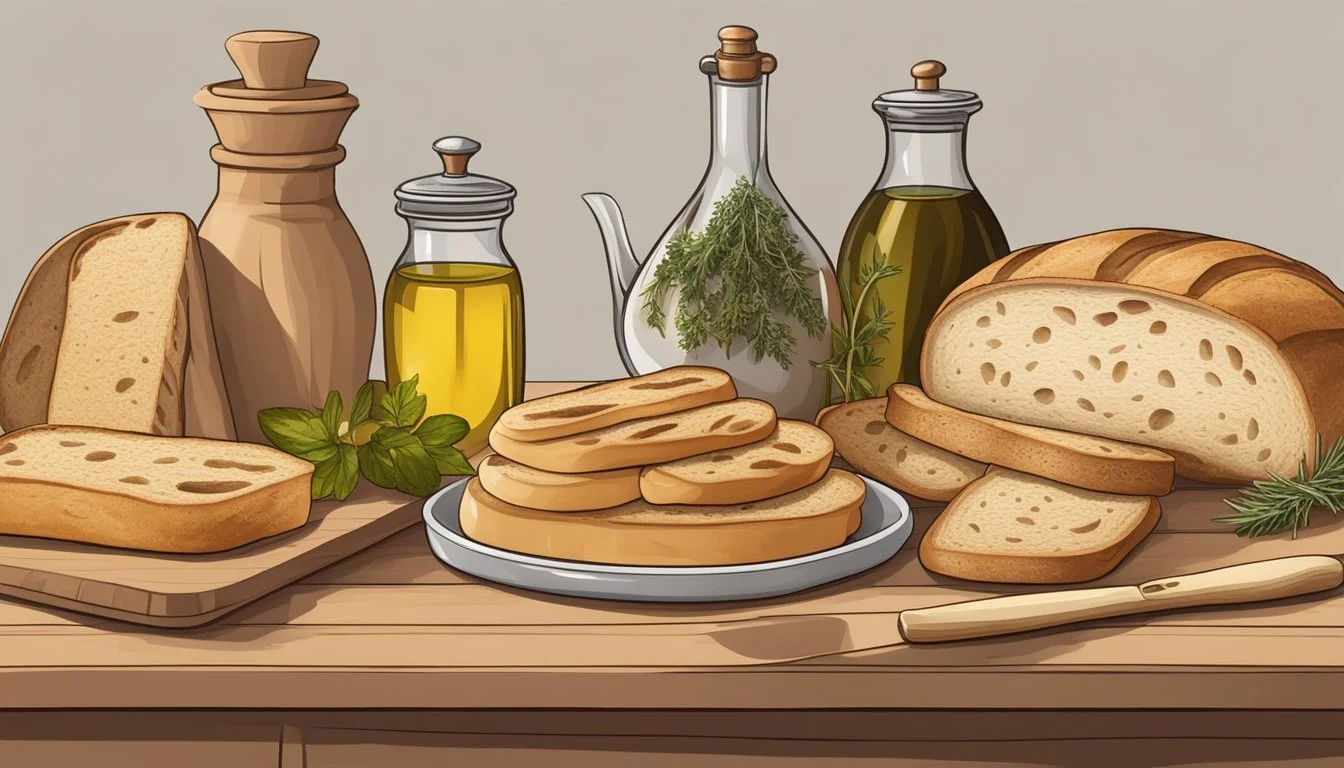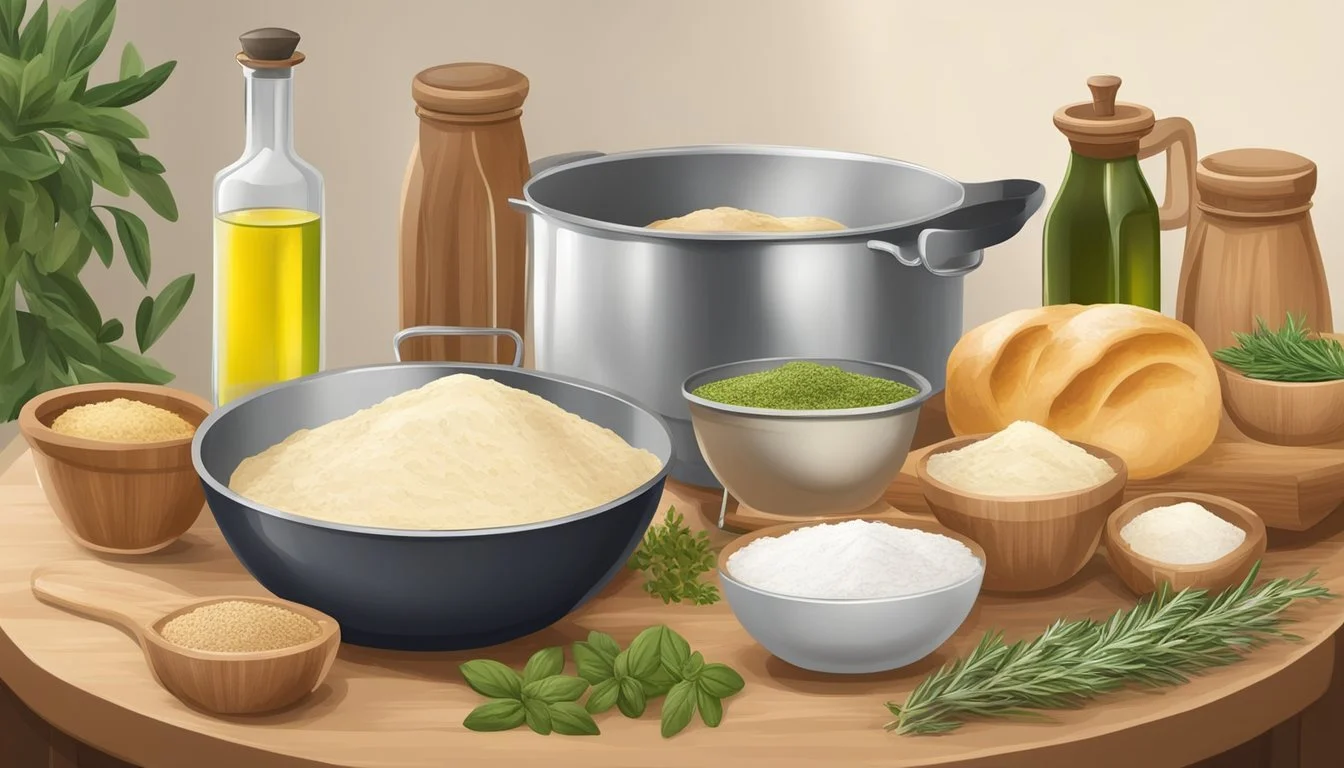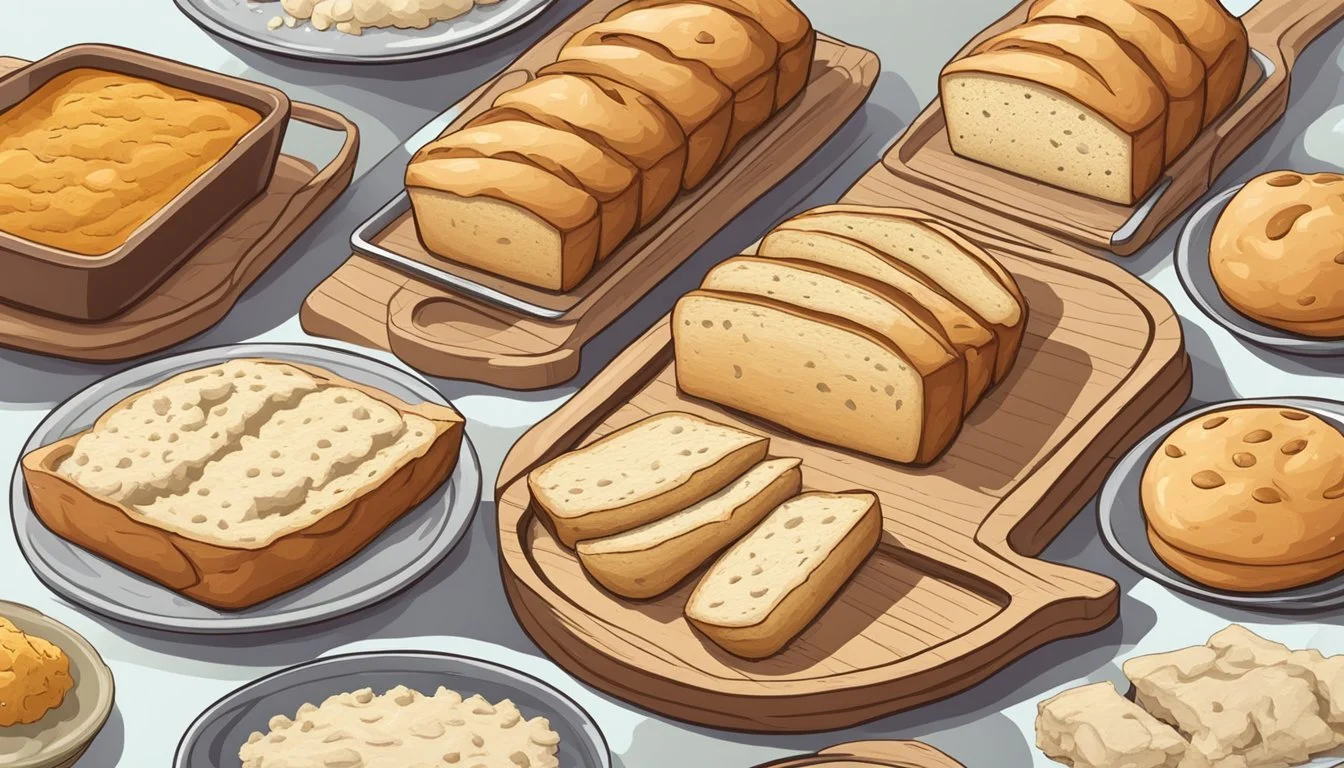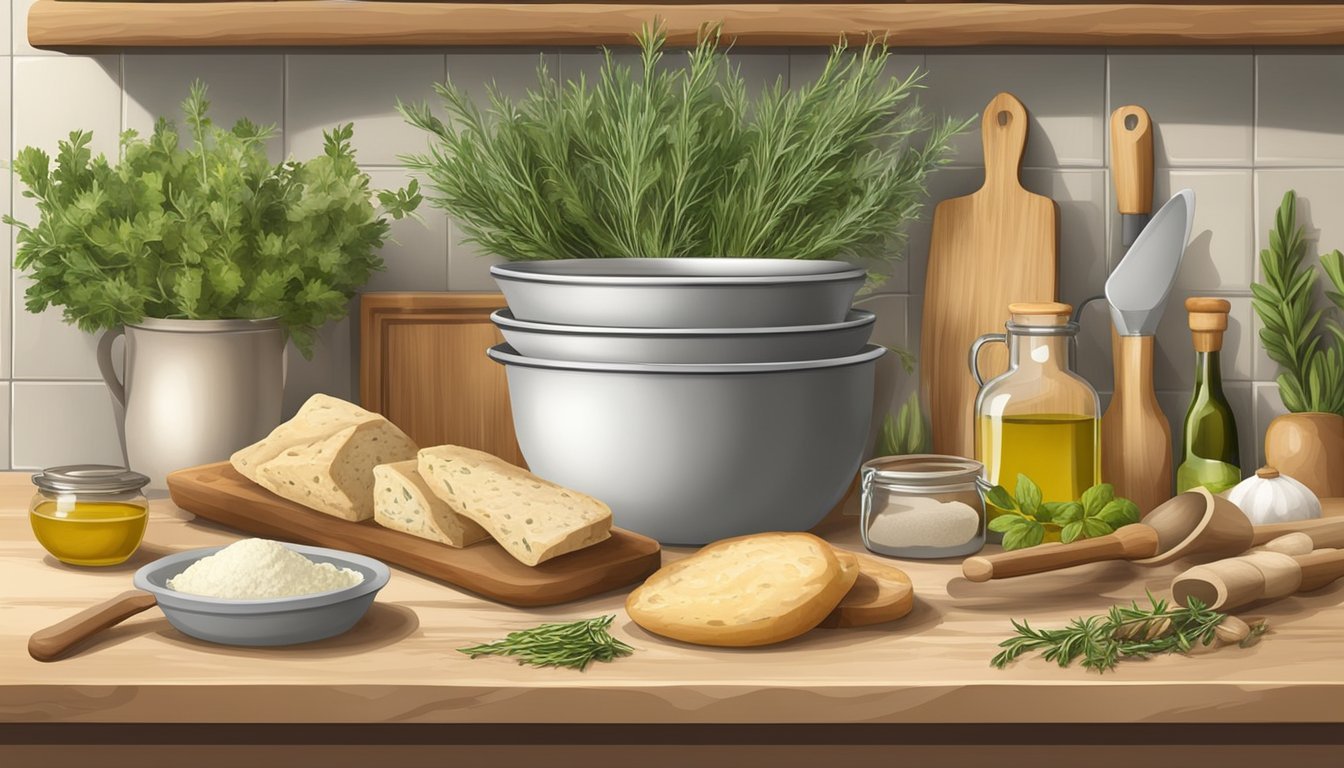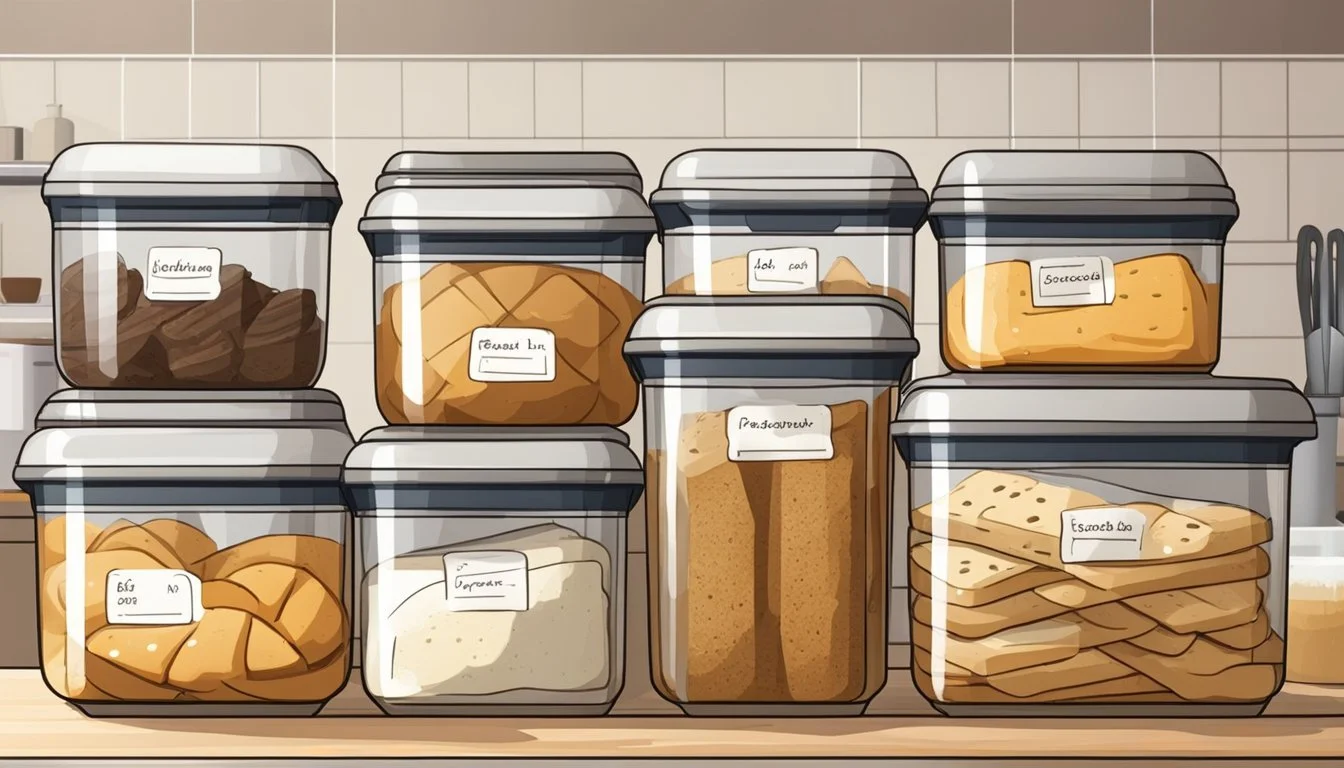Focaccia Bread Substitutes
Top Alternatives for Your Recipes
Focaccia bread, a staple in Italian cuisine, is beloved for its flavorful, olive oil-rich crust and soft, airy interior. This traditional flatbread, often embedded with herbs and toppings like onion, cheese, or olives, makes for a versatile side or base for a variety of dishes. Its distinctive taste and texture arise from a dough that is rich in olive oil and sometimes includes toppings added before baking.
However, not everyone has access to focaccia or the time to prepare it from scratch. Fortunately, a number of substitutes can provide a similar gustatory experience. Whole wheat bread, for example, offers a hearty and healthful alternative. It brings a different but appealing flavor profile that can complement many of the same foods as focaccia.
For those looking for an option closer in texture to the original, ciabatta bread serves as a commendable alternative. Ciabatta boasts a chewy texture and a slightly crispy crust, which can mimic the structural qualities of focaccia. Whether used in sandwiches, as a tool to scoop up dips, or enjoyed as a side, ciabatta provides a suitable and satisfying option for those seeking the essence of focaccia without the exact item.
Understanding Focaccia
Focaccia is a beloved Italian bread that is known for its rich olive oil content, flavorful herbs, and distinctive texture. This section delves into the bread's history, key components, and what makes its taste and texture so unique.
Historical Background of Focaccia
Originating from ancient Rome, focaccia (pronounced "foh-KAH-chyah") traces its roots back centuries as a staple of Italian cuisine. The term is derived from the Latin "focus," meaning hearth or fireplace, which is where it was traditionally baked. Regarded as a precursor to modern pizza, focaccia played an important role in the diets of Italians as a versatile and accessible food.
Key Ingredients in Focaccia
The basic recipe for focaccia includes:
Water and yeast: For the dough to rise.
Flour: Typically high-gluten flour is used for the right structure.
Olive oil: Liberally used to create a moist, tender crumb and crispy crust.
Salt: Preferably sea salt, for a burst of flavor and texture.
Optional ingredients can be added, such as different herbs like rosemary or thyme to infuse the bread with aromatic flavors.
Typical Focaccia Texture and Flavor
Focaccia's texture is a balance between chewy and fluffy, achieved by the reaction of yeast in the dough and the moisture from olive oil. The surface is often punctuated with dimples, which allow the oil to pool and infuse the bread while baking. The flavor profile is robust, characterized by the earthiness of the olive oil, the subtle bitterness of sea salt, and the freshness of herbs. The crust should be crisp and slightly golden, offering a satisfying contrast to the soft interior.
Common Focaccia Substitutes
When seeking an alternative to traditional focaccia bread, several options stand out for their comparable textures and flavors. Each substitute brings its unique characteristics to the table, from denser bread options to lighter, thinner choices that can adapt to a variety of dishes.
Ciabatta Bread as an Alternative
Ciabatta is a popular Italian bread with a similar heritage to focaccia. It offers a rustic appearance and a chewy texture with a crispy crust, making it an excellent substitute for focaccia in sandwiches or as a side for Italian entrees.
Using Pita Bread for a Quick Substitute
For those who prefer a quicker, thinner alternative, pita bread serves as a readily available substitute. Its soft, slightly leavened nature allows it to be used in much the same way as focaccia, especially when cut into wedges and served with dips.
Flatbread and Its Variations
Flatbread comes in various forms, each with its own set of characteristics that can mimic focaccia's versatility. Whether one opts for a Middle Eastern lavash, an Indian naan, or other regional flatbreads, their broad utility in wraps, as a base for toppings, or simply to soak up sauces makes flatbread a strong focaccia stand-in.
Pizza Dough for Versatility
Lastly, pizza dough is a versatile option that, when baked without toppings, results in a bread with a texture and taste close to focaccia. It can also be customized by adding herbs like rosemary or a sprinkle of coarse salt before baking to more closely resemble focaccia's distinct flavor profile.
Making Vegan Focaccia Bread
When adapting traditional focaccia recipes for a vegan diet, one focuses on plant-based ingredients without sacrificing the bread's characteristic taste and texture.
Ingredient Swaps for Vegan Focaccia
Ingredients play a pivotal role in turning classic focaccia into a vegan-friendly version. The essence of vegan focaccia lies in the exclusion of all dairy and animal-derived components. Here are the key swaps:
Olive Oil: Olive oil is already vegan and remains a crucial element, lending moisture and flavor.
Dairy-Free Alternatives: Traditional recipes may call for butter or cheese, which can be substituted with plant-based versions such as vegan butter or vegan cheese.
Vegan Meat: For toppings, instead of conventional meats, one can opt for seasoned tofu, tempeh, or commercially available vegan meat products.
Adapting the Recipe for Vegan Diets
To ensure the focaccia stays true to its nature while being plant-based, a few recipe modifications are in order:
Yeast: Active dry yeast is a vegan ingredient and is used in combination with sugar to help the bread rise.
Flour: Choose unbleached, all-purpose flour for the base of the dough.
Sweeteners: If a recipe calls for honey, replace it with maple syrup or agave nectar.
Liquid: Use lukewarm water to activate the yeast. Ensure it's not too hot to kill the yeast nor too cold to impede its growth.
It's essential to incorporate these elements carefully, respecting the balance of wet and dry ingredients to achieve a soft, airy texture characteristic of traditional focaccia.
Flour Varieties and Their Effects on Texture
The type of flour used in bread-making significantly influences the texture of the final product. Different flours have varying protein contents and gluten-forming capacities, which are critical in developing the bread's chewiness and structural integrity.
Bread Flour for a Chewier Crust
Bread flour contains a higher protein content, typically around 12-14%, which leads to more gluten development. For a focaccia substitute with a chewier crust and a robust structure, one can use bread flour. It absorbs more water, which enhances the dough's elasticity, resulting in a satisfyingly chewy texture.
All-Purpose Flour and Its Uses
All-purpose flour is a versatile option with a protein content that strikes a balance between bread flour and cake flour, usually around 10-12%. It is suitable for a variety of baked goods, including a focaccia substitute. All-purpose flour can produce a tender crumb while still offering enough gluten to give the bread decent shape and volume.
Incorporating Whole Wheat Flour
Whole wheat flour, made from the entire wheat kernel, contributes to a denser and heartier texture. It contains more fiber but also less gluten-forming protein compared to white flours. When used in combination with other flours for a focaccia substitute, whole wheat flour adds a nutty flavor and a more complex texture to the bread. Adjustments in hydration may be necessary, as whole wheat flour tends to absorb more liquid.
Mastering Focaccia Substitutes
When choosing a substitute for focaccia, the goal is crafting a bread that closely mimics its fluffy interior and crispy crust, while considering opportunities for creative customization.
Tips for Achieving Fluffy and Crispy Results
Substituting focaccia involves more than just finding a replacement; it’s about achieving the characteristic texture. A fluffy interior can be attained using whole wheat bread, which offers additional fiber and a satisfying bite. To ensure the crust becomes crispy, one should preheat the oven and possibly include a mist of water during the baking process to simulate focaccia's golden brown crust.
Preheat the oven to the right temperature before baking.
Consider adding a mist of water to the oven to help the crust crisp up.
Customizing with Toppings and Herbs
Focaccia is known for its flavorful toppings and herbs, such as rosemary. Substitutes can similarly be enriched. Ciabatta, another Italian bread with a chewy texture, serves as a fine canvas for such customizations. One can add a selection of toppings and herbs before the final baking period to infuse aromas and flavors that are reminiscent of classic focaccia.
Top with fresh herbs like rosemary for authentic flavor.
Add olives, onions, or sun-dried tomatoes for additional taste and texture.
Understanding the Importance of Oven Temperature
The oven plays a pivotal role in baking, influencing texture and color. For substitutes to achieve a crispy exterior like that of focaccia, the oven must be preheated to a high temperature, typically between 400-450°F (200-230°C). This heat allows the bread to cook quickly, creating a crisp exterior while retaining a soft, fluffy interior.
Preheat the oven to 400-450°F (200-230°C) for optimal results.
Use a baking stone or a preheated tray to ensure an evenly baked, golden brown crust.
Dietary Considerations and Modifications
When substituting focaccia bread, it's important to consider dietary needs such as gluten intolerance or sodium restrictions. Specific ingredients like yeast, salt, sugar, and water, as well as dairy-free options, can be adjusted to accommodate these needs.
Gluten-Free Focaccia Options
Gluten-sensitive individuals can opt for focaccia alternatives that use gluten-free flours. Such flours include almond, coconut, or rice flour. These substitutes often require a binding agent like xanthan gum to replicate the texture that gluten provides. Adding a gluten-free yeast ensures the bread can still rise properly. Here's a basic gluten-free focaccia recipe:
1 cup almond flour
1/2 cup water
1 tsp gluten-free yeast
1/2 tsp salt
1 tbsp olive oil
1/4 tsp xanthan gum (if needed)
Combine dry ingredients, then add wet ingredients and mix to form a dough. Allow to rise, shape, and bake until golden.
Low-Sodium Substitutes for Salt
Reducing sodium in diets is crucial for those monitoring their salt intake. For a low-sodium focaccia, one can use a salt substitute like potassium chloride or simply reduce the amount of salt called for in the recipe. Here's how to adjust the classic focaccia recipe:
Reduce salt to 1/4 tsp or use 1/4 tsp potassium chloride
Replace sodium-based baking soda with 1/2 tsp baking powder, if needed
This modification retains the characteristic flavor of focaccia while lowering the sodium content. Additionally, unsalted versions of other ingredients such as butter or dairy-free margarine can be chosen to further minimize sodium.
Preserving and Storing Focaccia and Its Substitutes
Focaccia bread and its substitutes have unique requirements for preservation. Understanding the right techniques for storage can significantly extend their freshness and flavor.
Effective Freezing and Thawing Techniques
To freeze focaccia, one should first cut it into portions suitable for later use. These pieces should be individually flash frozen on a baking tray for approximately one hour. Afterward, they can be transferred to freezer bags and kept frozen for optimal long-term storage.
When ready to enjoy the frozen bread, thawing can be done by transferring the desired amount to the refrigerator overnight to ensure gradual defrosting. Alternatively, for a quicker method, the bread can be heated directly in an oven until it regains its original texture and warmth.
Maintaining Freshness After Baking
Once baked, storing focaccia in the refrigerator is a suitable option for short-term preservation. It is best consumed within a few days, and storing it in this way can maintain its quality. The bread should be kept in an airtight container or wrapped tightly in plastic wrap to prevent moisture loss.
For those looking to rejuvenate day-old focaccia, reheating it in a preheated oven at 350°F to 375°F for 6 to 8 minutes can help restore its crispiness. Sliced focaccia may take less time, around 4 to 5 minutes, and one should watch carefully to avoid over-drying or burning.
Serving Suggestions and Pairings
Focaccia's versatility makes it an ideal choice for various culinary pairings, whether one's seeking a light snack or enhancing a full meal. Here's how to make the most of focaccia's rich flavors as an appetizer or a complementary side dish.
Creative Ideas for Focaccia Appetizers
Focaccia bread serves as a robust foundation for numerous appetizer ideas. Its fluffy texture and rich, olive oil-infused crust make it a satisfying prelude to any meal. For a simple yet flavorful snack, one might consider topping slices with garlic, fresh rosemary, and sea salt to emphasize its rustic taste. Alternatively, one can get creative by crafting bite-sized focaccia appetizers such as:
Garlic Focaccia Bites: Cut the bread into small squares and top with minced garlic and melted cheese, then broil until golden.
Rosemary Focaccia with Dips: Offer strips of herbed focaccia paired with assortments of dips like hummus or olive tapenade.
Focaccia as a Side Dish for Main Courses
When considering focaccia as a side, it complements a variety of main dishes, acting as the perfect vehicle to sop up sauces or provide textural contrast. Here are a few pairings where focaccia shines:
With Tomato Soup: Serve a hearty slice alongside a bowl of rich tomato soup for a comforting duo.
As a Sandwich Base: Utilize focaccia to construct a satisfying sandwich filled with roasted meats, veggies, and cheese.
By following these serving suggestions, focaccia can effortlessly transition from an appetizer to a side dish, making it a culinary chameleon on one's dining table.
Frequently Asked Questions
In this section, the reader will find solutions to common baking challenges associated with Focaccia bread, as well as tailored substitute recommendations to fit specific dietary needs.
Addressing Common Baking Challenges
When attempting to bake bread similar to Focaccia, one may encounter issues with texture and rise. Ciabatta is an excellent alternative, as it offers a similar chewy texture and large, airy holes. If the bread is too dense, one should ensure that the yeast is fresh and properly activated – a step that is critical for a light, airy loaf. High hydration in the dough can also help achieve the characteristic texture of Focaccia.
Substitute Recommendations for Specific Diets
For those adhering to specific diets, here are recommendations that adhere to low carbohydrate and gluten-free requirements:
Keto Diet: Replace traditional Focaccia with a Keto Focaccia Bread. Use almond flour in place of wheat flour to lower the carb count.
Ingredients Substitute With Wheat Flour Almond Flour Sugar (if applicable) Erythritol/Stevia
Gluten-Free Diet: Those needing a gluten-free option can opt for gluten-free bread mixes that are made specifically to mimic the texture of Focaccia.
By considering these aspects, one can enjoy Focaccia-like breads that cater to various dietary restrictions without compromising on taste and texture.

